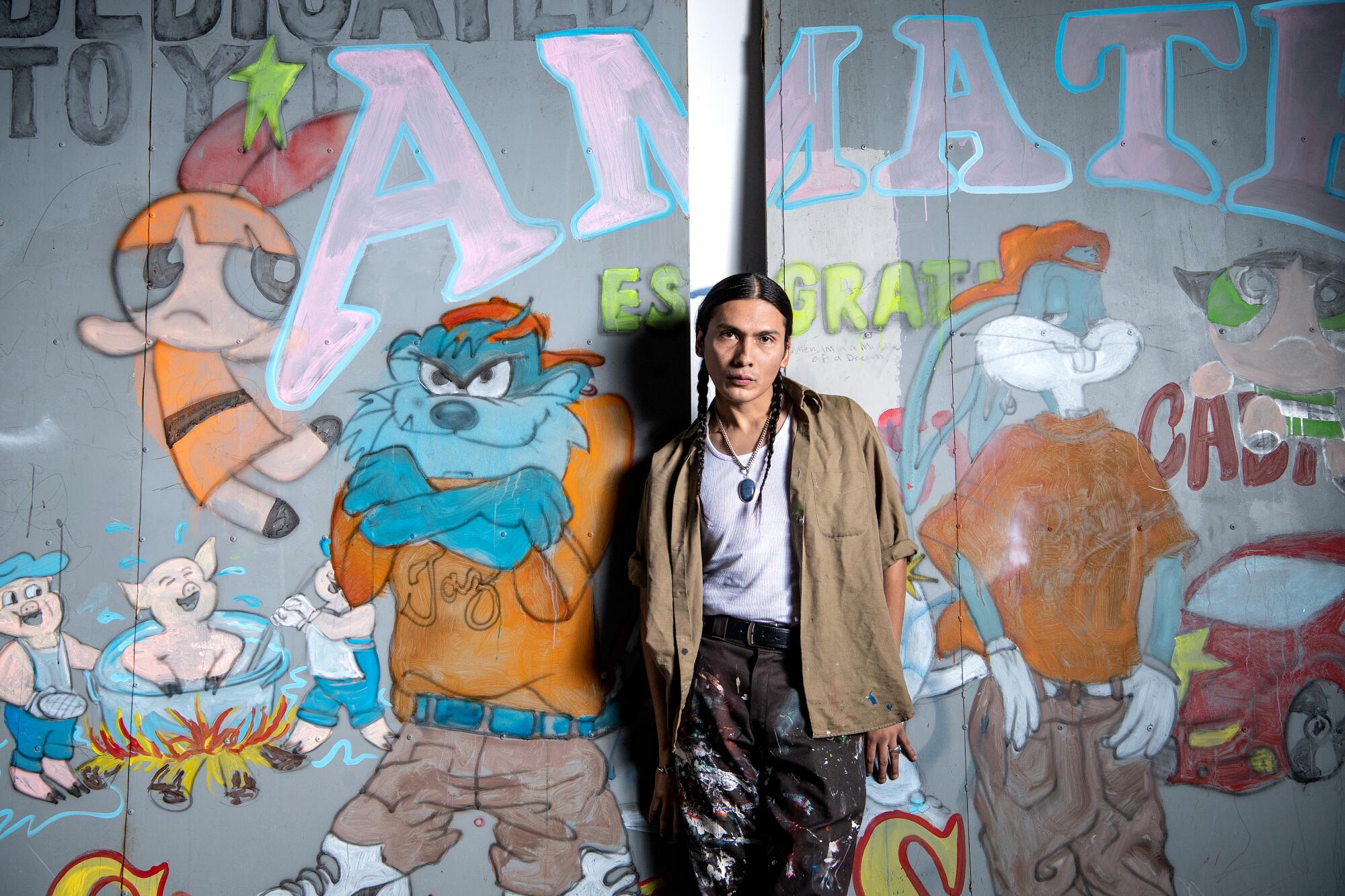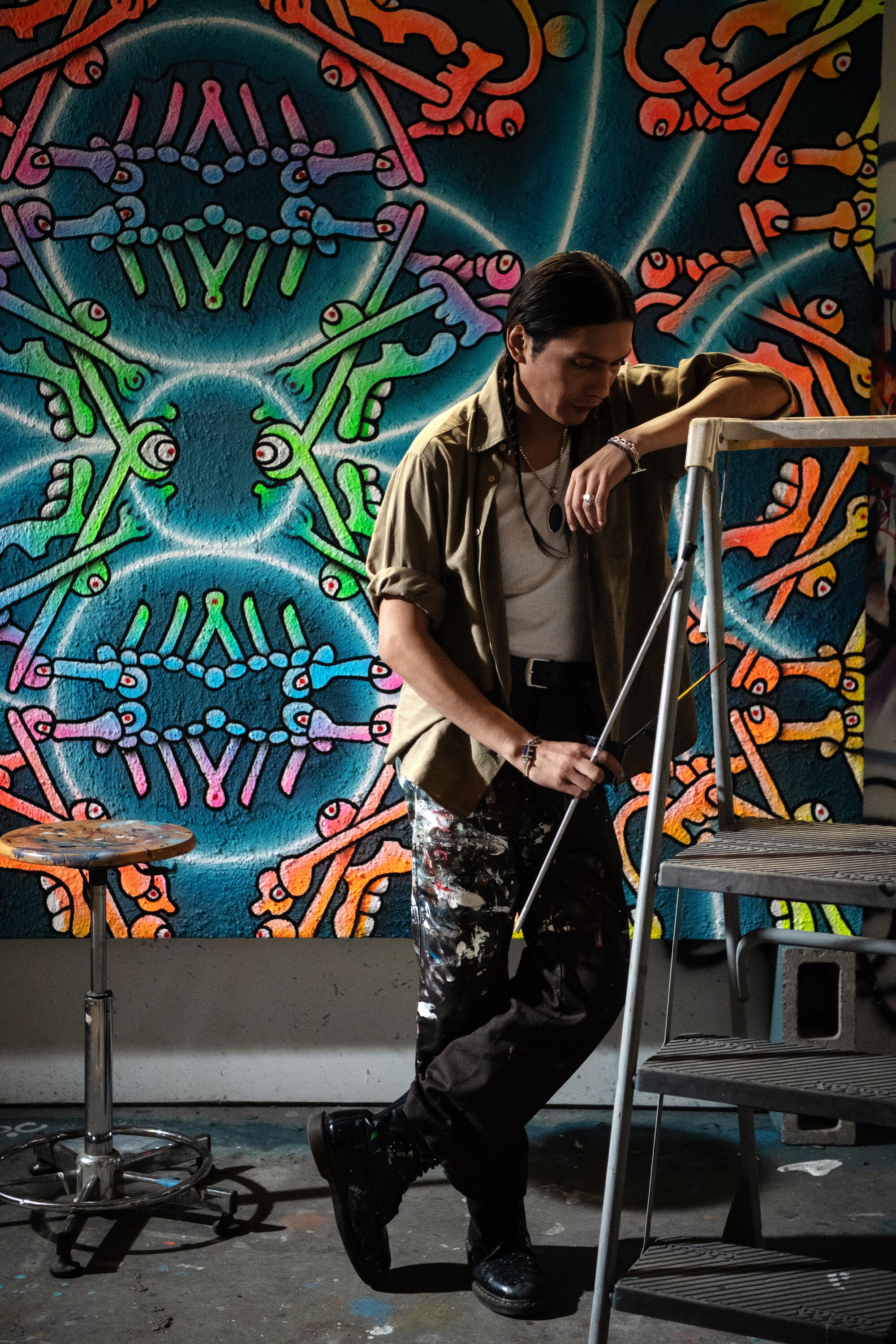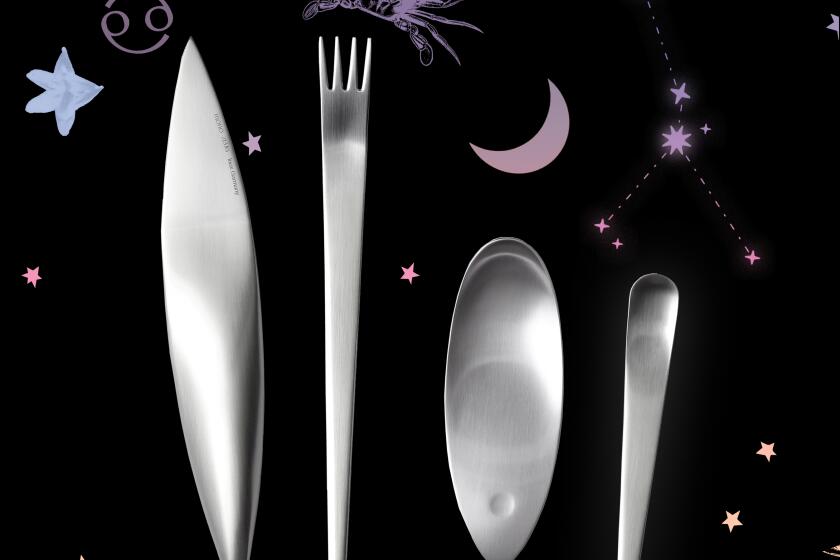
This story is part of Image Issue 16, “Interiority,” a living archive of L.A. culture, style and fashion that shows how the city moves from the inside. Read the whole issue here.
In 2021, Ozzie Juarez founded Tlaloc Studios, an artist studio and gallery in South Los Angeles that quickly became a beloved space for all kinds of creative people in the city. For Juarez, working alongside others has been integral to his process as an artist. “Coming together with others has always given everyone more opportunities,” he tells Lizette Hernández, an artist who also works out of Tlaloc Studios. In this conversation, the two artists and studio mates talk about the labor and intention that goes into making art and building a strong community.
Lizette Hernández: You and I met over 10 years ago, through working together at a part-time job while we were going to school, and a lot of what we connected on was over similarities in our upbringing and labor, like growing up working at swap meets. Can you talk a bit about your childhood and how you arrived at your creativity?
Ozzie Juarez: Like you said, these connections that brought us both together, like the hustle and connecting through the swap meet, I feel like those things are still so strong with me now. Tlaloc Studios is a swap meet, in a sense — everyone’s got their puestos, making their work in their studios; everyone’s working to sustain themselves. Starting there, with that business mentality, selling stuff, waking up really early and trying to make ends meet, and really putting your heart into it all — it gave me a way of living, or how to live, a structure, really. That’s one way that I started to become creative, being around the swap meet, because we were selling things that we basically were remaking, giving these objects different stories. Instead of saying, “Oh, we found it in the trash,” we’d give found objects new life. I feel like that’s what I do with my own paintings now, giving a different life to something that never really existed, like these big metal gates that are behind us — they were just trash before I picked them up, and now they’ll be painted and shown somewhere.

LH: It’s like the lack of access we had, or the lack of financial stability, has forced us to be creative, to really be inventive.
We grew up with the need to create access to spaces that weren’t available to the communities we come from. The first project space that you started was the South L.A. gallery space, SOLA gallery, that was above a mechanic shop, where many now-established painters and artists had some of their first opportunities to exhibit their work. What was the journey like for you to go from SOLA to the community and gallery space Tlaloc Studios?
OJ: I feel like the journey started way before SOLA did. Even before SOLA, friends and I would put on shows at skate parks or punk shows in backyards — it’s the same thing, you know, it just translates into a different thing. People are coming to look at art, people are coming for an experience. I’m here providing that experience, curating the experience.
I found the SOLA art gallery through music and being in community with other artists. I knew a musician named Richard Delgado, and he had a recording studio — the space was massive. I told him, “Hey, can I put together a gallery here?” And he agreed; I put my all into it and it was super cool. But his family didn’t really agree, and the father basically sold the space. It kind of did a lot to me and put me down, and I was like, “Well, I guess I’m not going to be an artist” and “I guess I’m not going to be a curator,” and so I got a job as a scenic painter at Disney. I worked there for 4? years, and it was just torture. It was exciting to be a painter at Disney, but making the commute and then having these bigger dreams — it wasn’t really working, spending my best creative years working at this company. I remember one time driving back and recording myself and basically trying to keep myself accountable for what I wanted to do. Then the pandemic happened, we all got fired, and then all these different opportunities that could have happened, happened to me. I invested all my savings and the money I received from the government into Tlaloc Studios. This community that we have is really strong. Each studio member brings so much — we all keep inspiring each other. We see the success at Tlaloc because we give — even with the name, Tlaloc, everything fits just so perfectly with this giving and receiving.
LH: Tlaloc being the god of rain.
When I think about you, I think of you as one of my most supportive friends — you’re constantly encouraging, not just me, but anyone who tells you that they are interested in art. You’re also an extremely dedicated and disciplined artist — you’re constantly grinding out as much as you can possibly create. Your work ethic always reflects back to me where we come from and the labor extremities that our families had to endure. How do you feel about your relationship to labor and play when you’re creating?


OJ: I feel like it just comes naturally — like we were saying, it’s just something that we always knew how to do. The creativeness and the hustle are almost the same thing; they go hand in hand. If you’re creative, you’re hustling — you’re making stuff, your mind is actively doing things. As a kid, I was always like that, I could never sit still — I was always scratching things on my bedroom walls. My mom could never give me a bag to take home from the market because I would spin it and rip it and it would be all destroyed. I’ve always been really destructive but creative at the same time.
LH: Both of us worked endlessly to put ourselves through art school. Primarily, it was to earn a degree in honor of the sacrifices our families offered to us by migrating to this country. And I feel that institutionally, in art school, we were taught that art-making is almost a passive act, separate from the artist’s experience — the idea being “art for art’s sake.” But I believe that making art is a very transformative experience, whether it’s processing ideas, experiences or even trauma. At times, it can be intentional or subconscious; you’re just working through it all. Do you view your process in this way at all? Does the act of working hard on a painting for long hours bring about something new within yourself?
More stories from Interiority
rafa esparza on the story of ‘Corpo RanfLA: Terra Cruiser’
Sam Muller unpacks the oral history of Hollywood High 16
Julissa James examines the style legacy of Homies
Angela Flournoy talks to Robin Coste Lewis about ‘deep time’
Alan Nakagawa remembers the Japanese market on wheels
OJ: Definitely. To be honest, I think that’s the reason why I paint so much. Because it puts me in that state where it’s healing, it’s like a drug — you get addicted to it. And when you’re in it, and you’re making these things, you’ve escaped, like you’re not there while also being fully present with yourself.
LH: You’re processing it.
OJ: Yeah, there’s this different world that you put yourself in. I see myself transforming through every painting. In every painting, I feel like I’ve evolved. When I’m painting, I’m making portals, I’m making this object that has a bunch of energy put into it — it’s, like, vibrating. It has to do a lot with the mental state that I’m in, the emotions that I pour in — and I feel so much.

LH: I guess I wouldn’t call it “escaping” — it’s the act of finding safety and refuge.
OJ: I think with my work, I feel less like I’m painting paintings, because it’s more of a trance — there’s this one image that’s repeated 100 times in this 8- by 7-foot painting and it’s just constant; I already know what to do. Sometimes the mind just gets to do its thing and sometimes it’s good, sometimes it’s bad — it shows in the work. The painting receives the energy, whether it’s bad or good energy, there’s energy.
LH: There is definitely a mesmerizing energy that comes through in your work. I think of our lineages and how we happen to be the first people in our families to make art in an “art gallery” context. When looking at your work, I see memories and stories that are being uncovered. Your paintings have somewhat sculptural elements coming through, and your sculptures have painterly elements. How did you arrive at the materials that you use? Or how do you come up with the imagery that you portray?
OJ: I think it has to do with a long, long process of just trying to figure it out from one day to the next. It was a lot of time being in the studio and having those “aha” moments. When I was going to UC Berkeley, I came up with a series that was mainly involving cartoons and pornography. I wanted to be “Americanized” and not be considered a Chicano painter. How do I escape being a Chicano painter through my paintings? What’s American? Cartoons. What else is American? F—ing hypersexual s—.
During that time, I was also doing these little manuscripts, these little characters, a different language that I was creating. I was doing a lot of studying on my own time, because they had a crazy library, and so I’d look at pre-Columbian manuscripts, redraw things and create my own language, inspired by those manuscripts. And I just kept it in my files — I didn’t show it for a class or an assignment; it was just strictly made because I was interested in it, but I didn’t really want to show that work there because they wouldn’t get it.
I was super interested in this language through my father, because my father had embedded in me, “This is inside your blood.” This lineage — pre-Columbian, Mexica ancestry — is inside you. He would collect artifacts, even find artifacts by digging in his backyard in Mexico City and share stories with me. I was always super interested in this stuff but was always told that it wasn’t what’s poppin’ or what Americans are going to buy. So even growing up, with my own language, with Spanish, I was ashamed to know that language.

LH: You were made to feel shame by others.
OJ: Exactly. But I knew what I wanted to do. And I started seeing an influx of other artists who said, “F— you, I’m gonna do whatever the f— I want.” And it was obviously encouraging. My work changed dramatically from having that perspective.
Lizette Hernández, born in 1992 in Los Angeles, still lives and works in Los Angeles and received her bachelor’s degree from UCLA (2019). Through her art, Hernandez considers questions of spirituality and tradition to create ceramic works that investigate the notion of sacred objects. Her work has been included in exhibitions at Various Small Fires, Los Angeles; Fortnight Institute, New York; and Harkawik, Los Angeles.
More stories from Image









